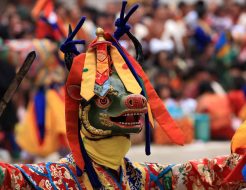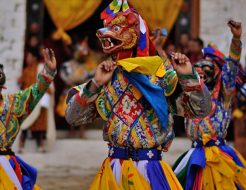The economy of Bhutan is a small economy with its latest annual GDP as meager as US$ 1.2 billion.
Until very recently, Bhutan’s economy was predominantly an agrarian one. About 70% of the country’s labor force continues to be absorbed in the agriculture sector. The private sector is witnessing a slow but steady growth. However, the contribution of the sector to the overall economy is negligible.
The government considers the private sector as the driver of the economy, but the claim has not been able to translate into concrete economic policies and actions.
The fledgling economy is the result of the country’s late entry into the club of modernizing regional and global economies. Bhutan implemented its first five-year plan only in the early 1960s. Today, the country is in the middle of the 10th Plan.
The weak and slow pace of economic development aside, Bhutan has seen its economy move some appreciable notches up the growth ladder from a mere traditional economy to a modern one in the last four decades.
At the moment there are three major sources of income for the country. They are from the sale of hydropower to India, tourism, and aids. The government is seriously looking to broaden and purify the economy. Thus, the effort of making use of the regional and global economic organizations is on the rise.
Bhutan launched its first ever Economic Development Policy in 2010. The document is considered to be the road map of the country’s economy. It seeks to strike a balance between economic growth and development.
The documents recognition of the importance of the private sector and the rural economy is quite promising. The private sector is considered the engine of growth while the rural economy the source of livelihood for the majority of the population.
Further, keeping in mind the importance of foreign investment in the development of the country’s economy, the government adopted quite a liberal Foreign Direct Investment Policy in 2010. The government goes to the extent of giving land ownership to the foreign investors to attract capital from abroad.
Given a small population with limited natural resources, Bhutan seriously considers making its economy a knowledge-based one. That is why unprecedented efforts are directed toward building the world class educational, health, and medical centers in the country.
The importance of research and development is felt today like never before. And several moves are made at the government and the private sector levels to collaborate with foreign economies in some critical development areas.
Bhutan strongly believes in a holistic economic development. Thus, it has been very cautious in liberalizing its economy. The country considers rapid economic growth at the expense of its cultural and traditional values bad.
Toward this end, Bhutan has chosen Gross National Happiness as its economic development model. The country rejects the one-time profiting out of its natural resources. And sustainable economic development is one of the core pillars of Gross National Happiness. This means Bhutan does not follow the GDP economic development principle.
The unique development philosophy attempts to strike a balance between material and spiritual wealth. The unconventional and holistic economic development approach costs the country. Its GDP growth over the years has been slow, though inclusive most times.
In most of the five-year plans, the allocation of budget both in terms of current and capital is the highest in the social sectors – health and education.
The major challenge the country considers in pursuing its development philosophy is the existing skewed wealth distribution among different social strata and regions.
And some of the immediate national concerns are rising unemployment and high level of poverty. The national unemployment rate stands at about 4% which is pretty high considering the proportion of the unemployed to a small population.
Worst, most of the unemployed are school drop-outs and college graduates and people from the poor economic background. And those living in food poverty make 23% of the total population, concentrated mostly in the rural areas.
Bhutan’s financial system is small which bears a strong correlation with its economic development level. The country has just four commercial banks and a dormant stock exchange. The two new commercial banks are not even a year old.
The scenario shows the country has not fully moved into a monetary economy. In a few pockets trade in goods for goods still exists.
The manufacturing base of the economy is still small. Main export goods are electricity, vegetable oil, fruits, and some minerals. The export destinations are mainly the South Asian economies with India being the largest. And the country’s currency (Ngultrum) is pegged at par with that of Indian Currency (Rupee).
On the import front, all the essential consumer products and construction materials are bought mostly from India. However, Bhutan trades with dozens of other countries spanning as far as Europe and America.
Bhutan’s economy at the moment could well be said to consist a mix of traditional and modern economic characteristics. But it is changing quite fast.
Book a Tour

Bhutan Naked Festival 2024
The Jambay Lhakhang, situated in Bumthang and en route to the Kurjie Lhakhang, is the venue for…
Start Date: 15th November 2024
End Date: 18th November 2024
Destination: Jambay Lhakhang, Choekhor, Bumthang

Bhutan Thimphu Festival Tour 2024
One of the biggest festivals in the country is the Thimphu Tshechu. This Thimphu festival tour is…
Start Date: 13th Sept 2024
End Date: 15th Sept 2024
Destination: Tashi Chhodzong, Thimphu

Punakha Festival Tshechu 2024
Punakha, situated in the western part of Bhutan, serves as the winter residence of the Je Khenpo,…
Start Date: 19th - February 2024
End Date: 21st February 2024
Destination: Punakha Dzong

Paro Bhutan Festival 2024
The Paro Festival, an annual event held every spring, stands as one of the most vibrant and…
Start Date: 21st March, 2024
End Date: 25th March, 2024
Destination: Rinpung Dzong, Paro
CONTACT US
- homeThimphu, Bhutan
- emailbookbhutantour@gmail.com
- emailinfo@bhutantouragency.com
- +975-17614054
- +975-02-340662
- +975-17614054
- rdtamang




